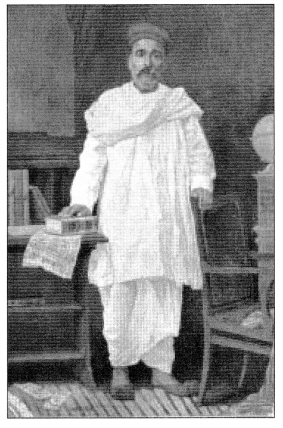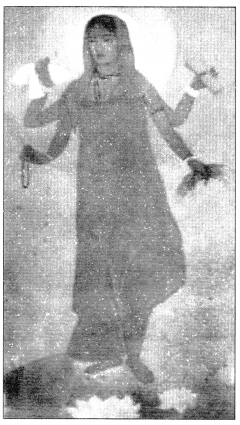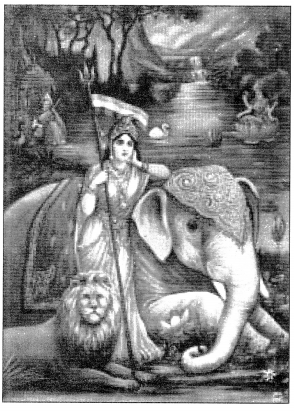NEW LEARNET EDUCATION
CHAPTER - 2 Nationalism in India
MCQ
1. Who was the writer of the book ‘Hind Swaraj’?
(a) Rabindranath Tagore
(b) B.R. Ambedkar
(c) Mahatma Gandhi
(d) Jawahar Lai Nehru
Answer
Answer: c
2. Khilafat Committee was formed in 1919 in the city of
(a) Bombay
(b) Calcutta
(c) Lucknow
(d) Amritsar
Answer
Answer: a
3. The Non-cooperation Khilafat Movement began in
(a) January 1921
(b) February 1922
(c) December 1929
(d) April 1919
Answer
Answer: a
4. Which of the following was the reason for calling off the Non-cooperation Movement by Gandhiji?
(a) Pressure from the British Government
(b) Second Round Table Conference
(c) Gandhiji’s arrest
(d) Chauri-Chaura incident
Answer
Answer: d
5. Baba Ramchandra, a sanyasi, was the leader of which of the following movements?
(a) Khilafat Movement
(b) Militant Guerrilla Movement of Andhra Pradesh
(c) Peasants’ Movement of Awadh
(d) Plantation Workers’ Movement in Assam
Answer
Answer: c
6. Who set up the ‘Oudh Kisan Sabha’?
(a) Alluri Sitaram Raju
(b) Jawahar Lai Nehru and Baba Ramchandra
(c) Jawaharlal Nehru and Shaukat Ali
(d) Mahatma Gandhi
Answer
Answer: b
7. Under the presidency of Jawahahar Lai Nehru, the Lahore Congress Session of 1929 formalised the demand of
(a) abolition of Salt Tax
(b) ‘Puma Swaraj’ or complete independence
(c) boycott of Simon Commission
(d) separate electorate for the ‘dalits’
Answer
Answer: b
8. The ‘Simon Commission’ was boycotted because
(a) there was no British Member in the Commission.
(b) it demanded separate electorates for Hindus and Muslims.
(c) there was no Indian Member in the Commission.
(d) it favoured the Muslims over the Hindus.
Answer
Answer: c
9. A form of demonstration used in the Non-cooperation Movement in which people block the entrance to a shop, factory or office is
(a) Boycott
(b) Begar
(c) Picketing
(d) Bandh
Answer
Answer: c
10. Who formed the ‘Swaraj Party’ within the Congress?
(a) Jawahar Lai Nehru and Motilal Nehru
(b) Abdul Ghaffar Khan and Mahatma Gandhi
(c) Jawahar Lai Nehru and Subhas Chandra Bose
(d) C.R. Das and Motilal Nehru
Answer
Answer: d
11. Who founded the ‘Depressed Classes Association’ in 1930?
(a) Alluri Sitaram Raju
(b) C.R. Das
(c) M.R. Jayakar
(d) Dr B.R. Ambedkar
Answer
Answer: d
12. Which party did not boycott the Council elections held in the year 1921?
(a) Swaraj Party
(b) Justice Party
(c) Muslim League
(d) Congress Party
Answer
Answer: b
13. What do you mean by the term ‘Begar’l
(a) An Act to prevent plantation workers to leave the tea gardens without permission.
(b) The forced recruitment of soldiers in rural areas during World War I.
(c) Labour that villagers were forced to contribute without any payment.
(d) Refusal to deal and associate with people, or participate in activities as a form of protest.
Answer
Answer: c
14. Where did Mahatma Gandhi start his famous ‘Salt March’ on 12th March 1930?
(a) Dandi
(b) Chauri-Chaura
(c) Sabarmati
(d) Surat
Answer
Answer: c
15. Which industrialist attacked colonial control over Indian economy and supported the Civil Disobedience Movement?
(a) Dinshaw Petit
(b) Purshottamdas Thakurdas
(c) Dwarkanath Tagore
(d) Seth Hukumchand
Answer
Answer: b
16. Who visualised and depicted the image of ‘Bharat Mata’ through a painting?
(a) Bankim Chandra Chattopadhyay
(b) Rabindranath Tagore
(c) Natesa Sastri
(d) Abanindranath Tagore
Answer
Answer: d
17. Which of the following was Mahatma Gandhi’s novel method of fighting against the British?
(a) He used violent method of stone pelting.
(b) He used arson to bum down government offices.
(c) He fought with the principle of ‘an eye for i an eye’.
(d) He practised open defiance of law, ; peaceful demonstration, satyagraha and non-violence.
Answer
Answer: d
18. What does satyagraha mean? Choose one from j the following options.
(a) ‘Satyagraha’ means use of physical force to inflict pain while fighting.
(b) ‘Satyagraha’ does not inflict pain, it is a : non-violent method of fighting against oppression.
(c) ‘Satyagraha’ means passive resistance and is a weapon of the weak.
(d) ‘Satyagraha’ was a racist method of mass agitation.
Answer
Answer: b
19. What was the purpose of imposing the j Rowlatt Act?
(a) The Rowlatt Act forbade the Indians to : qualify for administrative services.
(b) The Rowlatt Act had denied Indians the right to political participation.
(c) The Rowlatt Act imposed additional taxes on Indians who were already groaning under the burden of taxes.
(d) The Rowlatt Act authorised the government to imprison any person i without trial and conviction in a court of j law
Answer
Answer: d
20. Where did the brutal ‘Jallianwala Massacre’ j take place?
(a) Amritsar
(b) Meerut
(c) Lahore
(d) Lucknow
Answer
Answer: a
21. Why did General Dyer order to open fire on a i peaceful demonstration at Jallianwala Bagh? Choose from the given options.
(a) He wanted to show his power.
(b) Firing was ordered because it was an unruly crowd.
(c) Because his object, as he declared later, was to ‘produce a moral effect’ to create fear in the minds of ‘satyagrahis’.
(d) He ordered to fire because he noticed a j sudden unrest in the crowd.
Answer
Answer: c
MCQ PART 2
Ouestion 1 :
The Non-cooperation Movement began on which one of the following dates?
(a) January 1921
(b) November 1921
(c) December 1921
(d) May 1921
Answer
Answer: (a) January 1921
Question 2.
In which of the following places Mahatma Gandhi organised satyagraha for the first time in India?
(a) Dandi
(b) Ahmedabad
(c) Kheda
(d) Champaran
Answer
Answer: (d) Champaran
Question 3.
Who among the following was associated with the formation of Swaraj Party within the Congress?
(a) Subhas Chandra Bose
(b) Motilal Nehru
(c) Jawaharlal Nehru
(d) Dadabhai Naoroji
Answer
Answer: (b) Motilal Nehru
Question 4.
In which of the following Indian National Congress sessions was the demand of‘Purna Swaraj’ formalised in December 1929?
(a) Madras Session
(b) Lahore Session
(c) Calcutta Session
(d) Nagpur Session
Answer
Answer: (b) Lahore Session
Question 5.
Who organised the dalits into the Depressed classes Association?
(a) Dr. B.R. Ambedkar
(b) Jawaharlal Nehru
(c) Mahatma Gandhi
(d) Motilal Nehru
Answer
Answer: (a) Dr. B.R. Ambedkar
Question 6.
Why had the Congress ignored the dalits for long?
(a) Due to their liberal outlook
(b) Due to fear from the Britishers
(c) For fear of offending the sanatanis
(d) For fear of Dr B.R. Ambedkar
Answer
Answer: (c) For fear of offending the sanatanis
Question 7.
Who created the first image of Bharat Mata?
(a) Bankim Chandra Chattopadhyay
(b) Subhash Chandra Bose
(c) Rabindranath Tagore
(d) Abanindranath Tagore
Answer
Answer: (a) Bankim Chandra Chattopadhyay
Question 8.
Which of the following combination of colours was there in the ‘Swaraj flag’ designed by Gandhiji in 1921?
(a) red, green and white
(b) red, green and yellow
(c) orange, white and green
(d) yellow, white and green
Answer
Answer: (a) red, green and white
Question 9.
Who announced a vague offer of‘Dominion Status’ for India in 1929?
(a) Lord Curzon
(b) Viceroy Irwin
(c) Lord William Bentick
(d) Lord Mountbalten
Answer
Answer: (b) Viceroy Irwin
Question 10.
Which of the following agreements gave reserved seats to the ‘Depressed classes’ in provincial and central legislative councils?
(a) Lucknow Pact
(b) Gandhi Irwin Pack
(c) Poona Pact
(d) None of these
Answer
Answer: (c) Poona Pact
Question 11.
In which year the Second Round Table Conference was held?
(a) 1931
(b) 1935
(c) 1938
(d) 1945
Answer
Answer: (a) 1931
Explanation:
In December 1931, Gandhiji attended the second round table conference by demanding separate electorates for dalit.
Question 12.
What was the demand of 1929 sessions of the Congress at Lahore ?
(a) Poorna Swaraj
(b) Right to speech
(c) Half authority
(d) None of these
Answer
Answer: (a) Poorna Swaraj
Question 13.
Who started the Swaraj Party?
(a) Jawaharlal Nehru
(b) Mahatma Gandhi
(c) C.R.Das
(d) C.R. Das and Motilal Nehru.
Answer
Answer: (d) C.R. Das and Motilal Nehru.
Explanation:
C. R. Das and Motilal Nehru formed the Swaraj Party because they wanted to enter the Provincial Councils and oppose British policies.
Question 14.
Why was the slogans demanding “Swatantra Bharat” important?
(a) It showed the greatness of Mahatma Gandhi
(b) They were going beyond their own locality and emotionally identifying with an all-India movement
(c) They were a unifying force of the Non-Cooperation Movement
(d) The various ways in which ‘Swaraj’ was interpreted by different people
Answer
Answer: (b) They were going beyond their own locality and emotionally identifying with an all-India movement
Explanation:
When the tribals chanted Gandhiji’s name and raised slogans demanding ‘Swatantra Bharat’, they were also emotionally relating to an all-India agitation. They were going beyond their own locality and emotionally identifying with an all-India movement.
Question 15.
When did the Jallianwalla Bagh incident take place?
(a) On 13 April
(b) On 15 August
(c) On 27 October
(d) On 10 March
Answer
Answer: (a) On 13 April
Explanation:
On 13 April the Jallianwalla Bagh incident took place. On that day a large crowd gathered in the enclosed ground of Jallianwalla Bagh, unaware of the martial law that had been imposed. Dyer entered the area, blocked the exit points, and opened fire on the crowd, killing hundreds.
Question 16.
What were boycotted during Non-cooperation movement?
(a) Foreign goods
(b) Food
(c) Water
(d) None of these
Answer
Answer: (a) Foreign goods
Explanation:
At the time of Non-cooperation movement foreign goods were boycotted as the symbol of foreign trade and it begins with the surrender of titles that the government awarded, and a boycott of civil services, army, police, courts and legislative councils and schools.
Question 17.
Who published ‘The Folklore of Southern India’?
(a) Natesa Sastri
(b) Dr.Ambedkar
(c) Mahatma Gandhi
(d) None of these
Answer
Answer: (a) Natesa Sastri
Explanation:
In Madras, Natesa Sastri published a massive four-volume collection of Tamil folk tales, The Folklore of Southern India.
Question 18.
What was the reason for Mahatma Gandhiji’s fast unto death in 1932?
(a) The clash with Dr. Ambedkar
(b) The Clash with Bose
(c) The clash with Nehru
(d) None of these
Answer
Answer: (a) The clash with Dr. Ambedkar
Explanation:
The clash with Dr Ambedkar over his demand for a separate electorate for Dalits which he thought would halt their integration into society, led mahatma Gandhi to do fast unto death in 1932.
Question 19.
Who was the two great writers of Bengal and Madras, who contributed to nationalism in the late nineteenth century?
(a) Rabindranath Tagore and Natesa Sastri
(b) Jamini Roy and Ravi Verma
(c) Rabindranath Tagore and Ravi Verma
(d) None of these
Answer
Answer: (a) Rabindranath Tagore and Natesa Sastri
Explanation:
The two great writers of Bengal and Madras, who contributed to nationalism in the late nineteenth century through folklore, were Rabindra Nath tagore and Natesa Sastri
Question 20.
Who was the President of the Muslim League in 1930?
(a) Mr. M.A. Jinnah
(b) Maulana Azad
(c) Abdul Ghaffar Khan
(d) Sir Muhammad Iqbal
Answer
Answer: (d) Sir Muhammad Iqbal
Explanation:
In 1930, Sir Muhammad Iqbal, as president of the Muslim League, reiterated the importance of separate electorates for the Muslims as an important safeguard for their minority political interests.
Question 21.
The Non-Cooperation Movement was started by Mahatma Gandhi in support of which movement?
(a) Khilafat
(b) Swaraj
(c) Khilafat and Swaraj
(d) none of these
Answer
Answer: (c) Khilafat and Swaraj
Explanation:
At the Calcutta session of the Congress in September 1920, he convinced other leaders of the need to start a non-cooperation movement in support of Khilafat as well as for Swaraj.
Question 22.
Who was the author of the famous novel ‘Anandamath’?
(a) Bankim Chandra Chattopadhyay
(b) Abanindranath Tagore
(c) Natesa Sastri
(d) Rabindranath Tagore
Answer
Answer: (a) Bankim Chandra Chattopadhyay
Explanation:
Bankim Chandra Chattopadhyay was the author of the famous novel ‘Anandamath’. In the 1870s he wrote ‘Vande Mataram’ as a hymn to the motherland. His novel Anandamath and widely sung during the Swadeshi movement in Bengal.
Question 23.
What was the reason behind clash between Gandhi Ji and Dr Ambedkar?
(a) Separate electorates would create division in the society.
(b) Separate electorates would slow down the progress of integration into society.
(c) With separate electorates, Dalit’s would gain respect in society.
(d) The condition of Dalit’s would become better.
Answer
Answer: (a) Separate electorates would create division in the society.
Explanation:
Gandhiji began fast unto death when Dr. B.R. Ambedkar demanded separate electorate for dalits because Separate electorates would create division in the society.
Question 24.
When did Gandhiji travelled to Champaran in Bihar?
(a) 1916
(b) 1920
(c) 1925
(d)1918
Answer
Answer: (a) 1916
Explanation:
In 1916 he travelled to Champaran in Bihar to inspire the peasants to struggle against the oppressive plantation system.
Question 25.
Which one of the following leaders headed Oudh Kisan Sabha?
(a) Jawahar Lal Nehru
(b) Mahatma Gandhi
(c) Subhash Chandra Bose
(d) Motilal Nehru
Answer
Answer: (a) Jawahar Lal Nehru
Explanation:
By October, the Oudh Kisan Sabha was set up headed by Jawaharlal Nehru, Baba Ramchandra and a few others. Within a month, over 300 branches had been set up in the villages around the region.
Picture-based Questions:
Question 1.
Identify the following personality (NCERT TB page 70) and write a short paragraph on him highlighting his contribution to the Indian national movement.
Answer
Answer:
This is the portrait of Bal Gangadhar Tilak, a great leader of Indian national movement. He played a very significant role in national movement. Indian National Congress was divided into two wings- Moderate and Extremist. He was the first extremist leader who declared “Swaraj is my birth right and I must have it”. He organised the nationalist movement in Maharashtra and brought it in conflict with the British government.
He united the moderates and extremists of Congress Party. He appealed Indian people to boycott British goods, British courts, schools and colleges. He was sent to jail numerous times by the Britishers. He infused the spirit of self sacrifice among the Indian masses. Movement. Thus his contribution paved a new path to the Indian national movement.
Question 2.
Look at the picture taken from NCERT Textbook Page 71 and answer the questions that follow.
(i) What is this image of?
(ii) Who painted this image and when?
(iii) How does the painter portray Bharat Mata?
Answer
Answer:
(i) This is the image of Bharat Mata.
(ii) Abanindranath Tagore painted this image in 1905.
(iii) The painter portrays Bharat Mata as an ascetic figure. She is calm, composed, divine and spiritual.
Question 3.
Look at the picture taken from NCERT Textbook Page 72 and answer the questions that follow.
(i) What is depicted in the above picture?
(ii) What was its significance during the freedom struggle?
Answer
Answer:
(i) In this picture, Bharat Mata is shown with a trishul standing beside a lion and an elephant. These are the symbols of power and authority.
(ii) The image of Bharat Mata was an icon to create nationalist feeling in Indians during the freedom struggle. It shows that Indians should fight against the Britishers vehemently.
How do you think to help the depressed classes in India? Express your opinion.
Answer
Answer:
The depressed classes should be helped in India by the government NGOs and the society. At first, they must be given moral support so that they may come into the mainstream of the society. They must be provided educational facilities. This way they may come into the public and private sectors and their representation may be felt in the society.In politics they must be given proper representation.



0 Comments